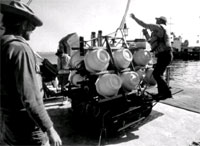Undersea explorer
 rover spends a lot of time exploring, digging and sniffing mud, but always returns home when its owner gives a whistle. But don't mistake it for a dog. Rover is an underwater tractor, a small treaded tank designed to spend months wandering in the murky ocean depths, searching the ocean floor for signs of life (New Scientist, Vol 153, No 2070).
rover spends a lot of time exploring, digging and sniffing mud, but always returns home when its owner gives a whistle. But don't mistake it for a dog. Rover is an underwater tractor, a small treaded tank designed to spend months wandering in the murky ocean depths, searching the ocean floor for signs of life (New Scientist, Vol 153, No 2070).
Rover set out on its maiden journey last year, about 75 km off Point Conception on the California coast. After a 4,000 m journey to the seabed , Rover began measuring the rate at which microscopic life in the seafloor's mud takes up and releases carbon. It can stay at the bottom for six months or more at a time and unlike one-shot instrument pods, can move from place to place, making a series of measurements.
Kenneth Smith, a marine biologist at Scripps Institution of Oceanography in La Jolla, California, and his colleagues began building Rover in 1992 with a us $800,000 development grant from the National Science Foundation, based in Washington dc. The team had to face two challenges. They had to ensure that the vehicle would tread lightly on the seafloor and to give it enough power to carry out its work. So they built their vehicle using plastics, fibreglass and lightweight titanium and made it buoyant with 17 football-sized glass globes. This means that Rover weighs 1,500 kg on the land but only 50 kg on the seafloor. "It was critically important to be able to make these readings without damaging the sediment we wanted to study," said Smith.
To power the tractor, the group needed a low-cost, self-contained energy source that could work in the dark. They settled on a pair of electric motors, one for each tread, run by batteries. The choice for batteries was quite complex. Lithium batteries worked well, but were too expensive. Lead-acid variety gave off gases and mercury cells showed unpredictable sudden power losses. Finally, the engineers equipped Rover with 300 alkaline d-cell batteries, the everyday variety that power large torches.
Rover's mission is hugely important. The metabolism of seabed organisms is part of the carbon cycle, the use and replenishment of carbon in the earth's ecosystems. The balance of carbon was delicately maintained until about the 18th century, when humans began to burn fossil fuels and the amount of carbon dioxide in the atmosphere suddenly began to rise from 280 parts per million (ppm) to 355 ppm today. The discrepancy is that fossil fuels should have produced a much bigger increase than this. Many researchers believe that the oceans have absorbed much of this extra carbon. If this is true, scientists are not at all sure as to what effect it will have on life under the sea. "We know almost nothing about the role of the seabed in the process, so we've created the Rover to help us find out," says Smith.
Rover's routine is a simple one. The two-metre square tractor floats down onto a flat part of the seabed. Once there, the vehicle trundles forward a few metres until its on-board inclinometer tells the central computer that it is level. Once the Rover is settled it lowers a shelf holding a package of instruments. It then pushes two open-bottomed cylinders about six centimetres into the sediment. Inside each cylinder, a stirring paddle spun at a slow pace of nine rotations per minute simulates the motion of current and replicates the rate at which gases and nutrients are naturally exchanged between the water and sediment. Every 15 to 30 minutes, Rover sucks water samples from each cylinder, measures their oxygen content and returns the samples to the cylinders, carefully filing away the results in its memory. After covering about 30 sites in about six months, Rover is ready to come home. Scripps engineers sail back to the spot and broadcast an acoustic signal for Rover to return to the surface. The message prompts Rover to release the clasps holding a 110-kg lump of steel to its belly. As it begins to rise to the surface, Rover emits an audible chirp to tell the ship where it is.
Some interesting findings have come from Rover's first mission. Between one and five per cent of the organic material originating at shallow depths drifts to the seabed in what had been assumed to be a steady stream. So until recently researchers believed that biological processes there were constant and slow, like their supply of food.
But the sediment traps of Rover have helped to confirm that this idea is wrong. The rate at which food from above arrives at the seafloor varies and the tempo of life matches these changes. "There are episodic fluxes which seem to drive the entire biological system," Smith says. "More food is suddenly produced on the surface and can't be consumed fast enough, so more of it falls to the bottom." Smith is interested in finding out how life on the surface and life on the seafloor are linked and how changes above effect life in the depths. This is a vital link in the carbon cycle that has still to be explored. "We're trying to develop a scenario of how these cycles are connected over time from the top to the bottom of the water column. The Rover will let us gather the data that we can use to begin to make conjectures," he explains.
